Please Stop Naming Vulnerabilities: Exploring 6 Previously Unknown Remote Kernel Bugs Affecting Android Phones
Prelude
In today’s world everyone knows that a security vulnerability isn’t really a security vulnerability unless it has been given a name other than a CVE, a Hype Krew has been hired to promote it, a blog post has been written for it, and a Blakhat talk is delivered. To continue with the tradition of naming and hyping bugs, I present to you “Please Stop Naming Vulnerabilities”, 6 remote (proximal) Kernel memory corruption bugs present in some routers and Android phones, including Google’s Pixel(XL) and Nexus 5x.
Introduction
For the past two years I spent time auditing various Android kernels looking for vulnerabilities. Over these two years I’ve found and reported around fifty bugs. In late 2016 and early 2017 I became burned-out from hunting bugs as it became a race between some very talented researchers and I. For example Derrek and I spent 2 months auditing and coding up PoCs for some bugs in a wifi driver where nearly 95% of our reports were duplicates with the Chinese teams. It was becoming hard to compete with teams who do this 40 hours a week while I do it as a hobby over coffee on Saturday mornings.
After the burnout subsided, I wanted to find some super cool bugs to reignite my interest in hunting, and, of course, find a reason to use this domain. As a result I decided to start looking for remote memory corruption bugs. There are 8 remote bugs to talk about, but as of November 2017 only 6 are released in bulletins. I wrote about each bug and planned to dislocse all at once, but I guess we’re doing this in batches of 6. And, for what it’s worth, all the fixes are in the public repos, which means you can go find them.
I would like to thank Steve and Robert for proofreading this and making it coherent.
Technical Introduction
The bugs I found are in the qcacld Qualcomm/Atheros wifi driver which is shipped in at least two phones I am aware of (Pixel’s, Pixel’s Gen2, and 5x’s). Unlike the Broadcom wifi SoC that Gal Beniamini blogged about, or Nitay owned, the Qualcomm SoC is a partial SoftMAC, meaning some Media Access Control (MAC) Sublayer Management Entity (MLME) is handled in host software, not on hardware or in SoC firmware. Because of this, the source code for handling any sort of 802.11 management frames must be in the driver and is thus available to look at.
Knowing where to look turned out to be more difficult than I hoped for. Anyone who has found bugs in the qcacld driver or written code for it, can attest to its confusing interfaces. Just to show you how out of control this driver truly is let’s see how many lines of code it took to implement it:
scotty@hacktheplanet:~/android/msm/drivers/staging/qcacld-2.0$ find . -name '*' | xargs wc -l
177 ./wcnss/inc/halCompiler.h
826 ./wcnss/inc/wlan_nv.h
690986 totalAs you can see above, there are nearly 691k lines of code for this single wifi driver. My plan was to look for some interrupt from the wifi chipset firmware to host driver notifying it of available packets and frames. From there I planned to follow the call chains until I found a bug. Unfortunately I could no pinpoint the true entry into the host drive and eventually gave up. In a last ditch effort, I started greping for features I knew a wifi driver might have to implement. At the time of hunting (Feburary and March 2017) for these bugs Gal hadn’t written his blog post so I didn’t have any of the good tips he provided. I knew there were de-authentication frames, so I started grepping for that.
Luckily I was greeted with the following:

I quickly zoned in on CORE/MAC/src/pe/lim/limProcessDeauthFrame.c:96:. From there I decided to see what else was in this directory:

As you can see there a plethora of files dedicated to management frames. It seemed as if I found the right location. The last thing I needed to do before auditing was confirm this code was actually used. I put a pr_err("%s: HELLO WORLD!\n", __func__); in the main function handler for 802.11 management frames and confirmed that the code was in use.
Basics for the bug:
Before I can explain the bugs, it is requird that you understand the surrounding code. At some point in the call chain after notification from the firmware of packets, we’ll enter into this function:
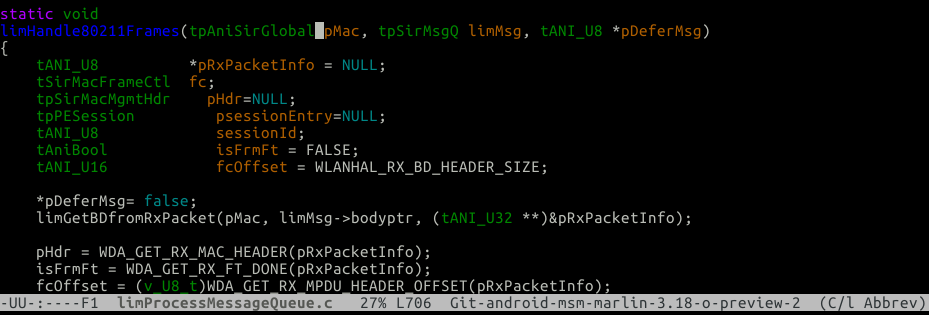
In this function we’ll verify the packet is a management frame, we’ll parse the subtype and call the correct management handler:
switch (fc.type)
{
case SIR_MAC_MGMT_FRAME:
{
// Received Management frame
switch (fc.subType)
{
case SIR_MAC_MGMT_ASSOC_REQ:
// Make sure the role supports Association
if (LIM_IS_BT_AMP_AP_ROLE(psessionEntry) ||
LIM_IS_AP_ROLE(psessionEntry))
limProcessAssocReqFrame(pMac, pRxPacketInfo, LIM_ASSOC, psessionEntry);
else {
// Unwanted messages - Log error
limLog(pMac, LOGE, FL("unexpected message received %X"),limMsg->type);
}
break;
case SIR_MAC_MGMT_ASSOC_RSP:
limProcessAssocRspFrame(pMac, pRxPacketInfo, LIM_ASSOC,psessionEntry);
break;
case SIR_MAC_MGMT_REASSOC_REQ:
// Make sure the role supports Reassociation
if (LIM_IS_BT_AMP_AP_ROLE(psessionEntry) ||
LIM_IS_AP_ROLE(psessionEntry)) {
limProcessAssocReqFrame(pMac, pRxPacketInfo, LIM_REASSOC, psessionEntry);
} else {
// Unwanted messages - Log error
limLog(pMac, LOGE, FL("unexpected message received %X"),limMsg->type);
}
break;
case SIR_MAC_MGMT_REASSOC_RSP:
limProcessAssocRspFrame(pMac, pRxPacketInfo, LIM_REASSOC,psessionEntry);
break;
case SIR_MAC_MGMT_PROBE_REQ:
limProcessProbeReqFrame_multiple_BSS(pMac, pRxPacketInfo,psessionEntry);
break;
case SIR_MAC_MGMT_PROBE_RSP:
if(psessionEntry == NULL)
limProcessProbeRspFrameNoSession(pMac, pRxPacketInfo);
else
limProcessProbeRspFrame(pMac, pRxPacketInfo, psessionEntry);
break;Once the correct handler is called, we need to parse the packet from a raw over-the-wire (over-the-air) form to a c-style structure we can use.
This conversion happens in the behemoth file dot11f.c which is file that is compiler generated and handles the conversions.
An example of the over-the-wire raw bytes to a c-style struct can be seen below:

Interestingly, after we parse from over-the-wire bytes to the c-style structure, we’ll also have to parse it even further from a c-style structure to another c-style structure. The dot11f c-style structures have every field that can be in the 80211 management frames. So for example, if the management frame can contain a list of capabilities, there will be a struct in the dot11f “out” structure for capabilities. The driver may not want to use these capabilities, so instead of passing around a large structure with ever single 80211 field it won’t need, it will further pull out items from the large structure into smaller structures. That way we’re only allocating memory for things the driver actually will use. This further refinement is handled in the following functions:

After refinement the driver uses the data however it needs to; what really happens after isn’t super relevant because that’s not where the bugs are. Below is a small graphic illustrating the data flow of packets.

The best bug (CVE-2017-11013):
Now that we have a general understanding of the high level and general data flow, let’s jump into the first and best bug.
The first bug is present in the dot11f.c file which as I’ve alluded to above is tasked with parsing over-the-wire packets to a c-style structure. When the dot11f.c file gets an over-the-wire packet the packet is structured in a series of Information Elements (IE)s where each IE is a Type-length-value (TLV). The IE consists of a one byte tag, one byte length and up to 255 byte value (Image stolen From Gal’s blog post on project 0):

The tags are standardized to represent specific types of elements.
The dot11f.c code is littered with IE definitions which represent what could possibly be contained in a packet. For instance, let’s say we, on our phones try to connect to our home network. At some point in the protocol chain, the Access Point will send back to us an association response. When the phone gets the association response packet, the driver will eventually call dot11fUnpackAssocResponse which will immediately call UnpackCore:

Let’s decompose the call to UnpackCore a bit. pCtx is the driver’s state structure, pBuf is the over-the-wire list of TLVs, nBuf is the total size of pBuf, FFS_AssocResponse is a list of mandatory IEs that must be in pBuf, and IES_AssocResponse is a list of optional IEs that can be in pBuf. pFrm is our “out” structure, meaning the parsed IEs will be translated into the members of the tDot11fAssocResponse struct.
I’m about to dump a ton of struct definitions here, but they’re all important to understand the bug.Ssorry and try and follow along!
Let’s take a look at the definition of the IES_AssocResponse structure. Remember this is the list of optional IE members the packet can contain:
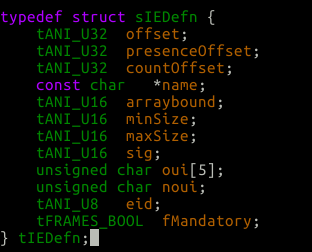
Now take a look at the definition of the “out” structure tDot11fAssocResponse:
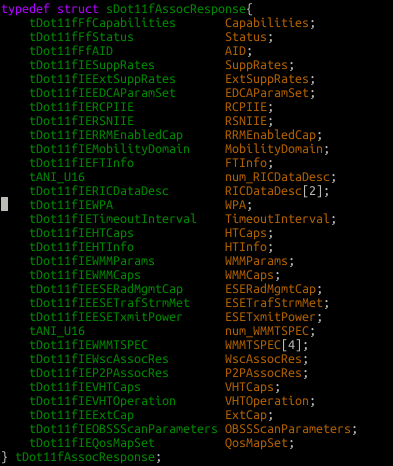
For each member of tDot11fAssocResponse structure there is a corresponding tIEDefn structure in IES_AssocResponse array. Now translate the tIEDefn structure to English with respect to the out structure.
typedef struct sIEDefn {
tANI_U32 offset;
/* This is the offset into the out structure
* where we will place the parsed data.
* So for instance the out structure can
* Contain tDot11fIEExtSuppRates ExtSuppRates;
* We would do:
* .offset = offsetof(tDot11fAssocResponse, ExtSuppRates)
*/
tANI_U32 presenceOffset;
/* Each member in the out structure has a present
* flag which gets set if the parser saw the IE in
* the raw packet buffer and parsed data into the
* Out member.
*/
tANI_U32 countOffset;
/* Some IE's can be sent more than once in the raw
* tlv packet. This offset represents where in the
* Out structure the count for how many IEs of this
* type we've parsed lives. So for example, in the
* Assoc response go above and look for
* tDot11fIERICDataDesc RICDataDesc[2];
* and right above you'll see:
* tANI_U16 num_RICDataDesc;
* So we'll have a:
* .countOffset = offsetof(tDot11fAssocResponse, num_RICDataDesc);
*/
const char *name;
/* self explanatory, name of the IE we're parsing */
tANI_U16 arraybound;
/* If the parser accepts multiple IEs in a single packet
* of the same type, like we showed for RICDataDesc[2],
* this value represents how many IEs we can accept.
* So for a Assoc response frame there are 2 array bound
* vars:
* tDot11fIERICDataDesc RICDataDesc[2];
* tDot11fIEWMMTSPEC WMMTSPEC[4];
* Go back up to the picture of the Assoc Resp out frame and
* You'll see above each one there is a num_* representing
* once again how many of theses IE's we've parsed (count offset).
* So, for the RICDataDesc arraybound would = 2,
* and for WMMTSPEC arraybound = 4. Everything else would
* be 0.
*/
tANI_U16 minSize;
/* The minimum size of the IE */
tANI_U16 maxSize;
/* Maximum size of the IE */
tANI_U16 sig;
/* This is a unique number representing the IE, used
* internally for the parser. We'll see more about it
* later. It's just used as a case in a huge switch
* statement to get us to the right parser function
*/
unsigned char oui[5];
unsigned char noui;
/* So along with the eid below the IE can have a OUI
* which is mostly used with tag # 221 which is the
* Vendor tag. If we want to support multiple tag
* Number 221's each with different types we'll pass
* along an OUI which is just more bytes which represent
* a specific type of 221. noui is just how many OUI
* bytes we should look for.
*/
tANI_U8 eid;
/* eid is just the TLV Tag. Dunno why they didn't call it
* "tag"
*/
tFRAMES_BOOL fMandatory;
} tIEDefn;For the IES_AssocResponse list, which as a reminder is the optional IEs in the raw packet, it looks like the blow example. Each member is a tIEDefn we described above. As a quick example take a few of the members from below and map them the definitions above to make sure you understand how it’s setup! (I’ve removed a majority of the definitions because it’s so large):
static const tIEDefn IES_AssocResponse[] = {
{
offsetof(tDot11fAssocResponse, SuppRates),
offsetof(tDot11fIESuppRates, present),
0,
"SuppRates",
0,
2,
14,
SigIeSuppRates,
{0, 0, 0, 0, 0},
0,
DOT11F_EID_SUPPRATES,
1,
},
{
offsetof(tDot11fAssocResponse, ExtSuppRates),
offsetof(tDot11fIEExtSuppRates, present),
0,
"ExtSuppRates",
0,
3,
14,
SigIeExtSuppRates,
{0, 0, 0, 0, 0},
0,
DOT11F_EID_EXTSUPPRATES,
0,
},
...
...
...
{
offsetof(tDot11fAssocResponse, RICDataDesc),
offsetof(tDot11fIERICDataDesc, present),
offsetof(tDot11fAssocResponse, num_RICDataDesc),
"RICDataDesc",
2,
2,
550,
SigIeRICDataDesc,
{0, 0, 0, 0, 0},
0,
DOT11F_EID_RICDATADESC,
0,
},
...
...
...
{
offsetof(tDot11fAssocResponse, WMMTSPEC),
offsetof(tDot11fIEWMMTSPEC, present),
offsetof(tDot11fAssocResponse, num_WMMTSPEC),
"WMMTSPEC",
4,
63,
63,
SigIeWMMTSPEC,
{0, 80, 242, 2, 2},
5,
DOT11F_EID_WMMTSPEC,
0,
},
...
...
}So now that we understand some of the structure definitions the parser uses let’s take a look at the relevant parser code in UnpackCore:
while (nBufRemaining)
{
if (1 == nBufRemaining)
{
FRAMES_LOG0(pCtx, FRLOGE, FRFL("This frame reports "
"only one byte remaining after it's fixed fields.\n"));
status |= DOT11F_INCOMPLETE_IE;
FRAMES_DBG_BREAK();
goto MandatoryCheck;
}
pIe = FindIEDefn(pCtx, pBufRemaining, nBufRemaining, IEs);And the definition of FindIEDefn translated with comments:
At a high level FindIeDefn will loop over the entire optional IE
list, in our case IES_AssocResponse seeing if the buffer,
at the current index, contains the tag for the IE. So the function
will start at index 0 of the IES_AssocResponse array and say:
Does the buffer contain this eid? no, let’s try index 1, does it contain
this eid, no? let’s go to index 2, does it contain this eid, yes, okay
return the tIEDefn structure representing this eid.
static const tIEDefn* FindIEDefn(tpAniSirGlobal pCtx,
tANI_U8 *pBuf,
tANI_U32 nBuf,
const tIEDefn IEs[])
{
const tIEDefn *pIe;
(void)pCtx;
pIe = &(IEs[0]);
/* Start on the 0th index of our list of Optional IE's:
* IES_AssocResponse
*/
while (0xff != pIe->eid)
{
/* While we haven't reached the end of the IES_AssocResponse list */
if (*pBuf == pIe->eid)
{
/* If the raw packet at the current index has the current tag */
/* If there is no extra noui bytes to check return */
if (0 == pIe->noui) return pIe;
/* If the tags match and there is extra OUI data to compare let's compare */
if ( ( nBuf > (tANI_U32)(pIe->noui + 2) ) &&
( !DOT11F_MEMCMP(pCtx, pBuf + 2, pIe->oui, pIe->noui) ) )
return pIe;
}
/* The raw packet didn't match this IE definition, let's try the next one */
++pIe;
}
/* This IE isn't recognized for this type of frame, return NULL */
return NULL;
}Continuation of Unpack core immediately following the call to FindIEDefn:
pIe = FindIEDefn(pCtx, pBufRemaining, nBufRemaining, IEs);
/* So at this point let's just assume we have a proper pIe.
* let's say we saw a tDot11fIEWMMTSPEC IE.
*/
/* Extract the TAG from the Packet */
eid = *pBufRemaining++; --nBufRemaining;
/* Extract the Length from the packet
len = *pBufRemaining++; --nBufRemaining;
/* If we did find the IE Definition in the raw packet,
* we'll do some validation checks.
*/
if (pIe && pIe->noui)
{
if (pIe->noui > nBufRemaining)
{
FRAMES_LOG3(pCtx, FRLOGW, FRFL("IE %d reports "
"length %d, but it has an OUI of %d bytes.\n"),
eid, len, pIe->noui);
FRAMES_DUMP(pCtx, FRLOG1, pBuf, nBuf);
FRAMES_LOG2(pCtx, FRLOG1, FRFL("We've parsed %d by"
"tes of this buffer, and show %d left.\n"), pBufRemaining - pBuf, nBufRemaining);
status |= DOT11F_INCOMPLETE_IE;
FRAMES_DBG_BREAK();
goto MandatoryCheck;
}
pBufRemaining += pIe->noui;
nBufRemaining -= pIe->noui;
len -= pIe->noui;
}
/* If the TLV reports a Length greater than the amount of data
* left in our buffer we will bail out. This will prevent
* an OOB read.
*/
if (len > nBufRemaining)
{
FRAMES_LOG3(pCtx, FRLOGW, FRFL("IE %d reports length %"
"d, but there are only %d bytes remaining in this"
" frame.\n"), eid, len, nBufRemaining);
FRAMES_DUMP(pCtx, FRLOG1, pBuf, nBuf);
FRAMES_LOG2(pCtx, FRLOG1, FRFL("We've parsed %d by"
"tes of this buffer, and show %d left.\n"), pBufRemaining - pBuf, nBufRemaining);
status |= DOT11F_INCOMPLETE_IE;
FRAMES_DBG_BREAK();
goto MandatoryCheck;
}
/* If our call to FindIEDefn did find an IE we recognize in
* The packet let's start parsing it:
if (pIe)
{
/* do some more size validations */
if (nBufRemaining < pIe->minSize - pIe->noui - 2U)
{
FRAMES_LOG3(pCtx, FRLOGW, FRFL("The IE %s must be "
"at least %d bytes in size, but there are only"
"y %d bytes remaining in this frame.\n"),
pIe->name, pIe->minSize, nBufRemaining);
FRAMES_DUMP(pCtx, FRLOG1, pBuf, nBuf);
status |= DOT11F_INCOMPLETE_IE;
FRAMES_DBG_BREAK();
goto MandatoryCheck;
}
else
{
/* Some weird check that doesn't really do anything except
* complain in dmesg.
*/
if (len > pIe->maxSize - pIe->noui - 2U){
FRAMES_LOG1(pCtx, FRLOGW, FRFL("The IE %s reports "
"an unexpectedly large size; it is presumably "
"more up-to-date than this parser, but this wa"
"rning may also indicate a corrupt frame.\n"),
pIe->name);
FRAMES_DUMP(pCtx, FRLOG1, pBuf, nBuf);
}
/* If our IE element is array bound, like I explained above:
* If our frame type can accept multiple IE's of the same type
* in the same packet we will grab the current Count of how
* Many we've already parsed and store it in countOffset.
* On the first iteration it will be 0, second time we see
* the same IE it will be 1, etc etc. If our IE element
* is not array bound countOffset will become 0.
*/
countOffset = ( (0 != pIe->arraybound) * ( *(tANI_U16* )(pFrm + pIe->countOffset)));
switch (pIe->sig) {
/* Now we switch on the signature which will take us to the correct parsing
* function.
* I've listed both cases for the two Array bound signatures in our
* Association response below:
*/
case SigIeRICDataDesc:
//reset the pointers back since this is a container IE and it doesn't have its own EID and Len.
pBufRemaining -= 2; nBufRemaining += 2;
if ( pIe && pIe->noui ) {
pBufRemaining -= pIe->noui;
nBufRemaining += pIe->noui;
len += pIe->noui;
}
status |= GetContainerIesLen(pCtx, pBufRemaining, nBufRemaining, &len, IES_RICDataDesc);
if (status != DOT11F_PARSE_SUCCESS && status != DOT11F_UNKNOWN_IES ) break;
status |= dot11fUnpackIeRICDataDesc(pCtx, pBufRemaining, len, ( tDot11fIERICDataDesc* )(pFrm + pIe->offset + sizeof(tDot11fIERICDataDesc)*countOffset) );
break;
...
...
...
/* in the case of a SigIeWMMTSPEC IE we'll call dot11fUnpackIeWMMTSPEC() */
case SigIeWMMTSPEC:
status |= dot11fUnpackIeWMMTSPEC(pCtx, pBufRemaining, len, ( tDot11fIEWMMTSPEC* )(pFrm + pIe->offset + sizeof(tDot11fIEWMMTSPEC)*countOffset) );
/* Let's break this call down a bit more:
* dot11fUnpackIeWMMTSPEC(pCtx,
* pBufRemaining,
* len,
* (tDot11fIEWMMTSPEC*)(pFrm + pIe->offset + sizeof(tDot11fIEWMMTSPEC) * countOffset));
*
*
* The most interesting portion of this call is the last parameter.
* pFrm is the start -in memory- of our Out structure tDot11fAssocResponse.
* pIe->offset, like we described above is the amount of bytes
* into tDot11fAssocResponse where the tDot11fIEWMMTSPEC member
* lives. The second half of the math:
* sizeof(tDot11fIEWMMTSPEC) * countOffset will calculate
* the index into the array. Remember for the WMMTSPEC
* it looks like this in the out structure:
* tDot11fIEWMMTSPEC WMMTSPEC[4];
* So there are 4 slots in the array we can save.
* So like I said above the first time we do this we'll save into
* slot 0 because count offset will be 0.
*/
break;
...
...
...
default:
FRAMES_LOG1(pCtx, FRLOGE, FRFL("INTERNAL ERROR"
": I don't know about the IE signature %d"
"-- this is most likely a 'framesc' bug.\n"),
pIe->sig);
FRAMES_DBG_BREAK();
return DOT11F_INTERNAL_ERROR;
}
/* If we are array bound we'll add one to our num_*
* in the case of WMMTSPEC the below math will take us
* to the location in memory where the num_WMMTSPEC
* inside the tDot11fAssocResponse lives and we'll add
* one to it.
*/
if (pIe->arraybound) (++( *(tANI_U16*)(pFrm + pIe->countOffset) ));
/* At this point if there is remaining IE's in the input
* buffer we'll jump back up to the top of this while loop
* try and find another IE defn and parse the rest of the packet.
*/
}
}
}I’ve given enough information now that you should be able to spot the bug. If you’re like me and you like to try and see the bugs in blog posts before they spoil them go back up and keep reading the code. If you need a hint: What happens when we send another WMMTSPEC IE in our Association response, how will it get parsed, what index will it get stored into on the 2nd iteration, what about the 3rd and 4th time we send a WMMTSPEC IE?
The problem with the parsing code is we never validate countOffset\num_ against arraybound. Remember above I said countOffset\num_ represents how many elements we’ve currently parsed, and arraybound represents how many available slots we have. So I as an adversary can send let’s say 15 WMMTSPEC IE’s and the parsing code will happily continue parsing them, storing them into slots 0->14. Remember we only have 4 slots for WMMTSPECS:
typedef struct sDot11fAssocResponse{
tDot11fFfCapabilities Capabilities;
tDot11fFfStatus Status;
tDot11fFfAID AID;
tDot11fIESuppRates SuppRates;
tDot11fIEExtSuppRates ExtSuppRates;
tDot11fIEEDCAParamSet EDCAParamSet;
tDot11fIERCPIIE RCPIIE;
tDot11fIERSNIIE RSNIIE;
tDot11fIERRMEnabledCap RRMEnabledCap;
tDot11fIEMobilityDomain MobilityDomain;
tDot11fIEFTInfo FTInfo;
tANI_U16 num_RICDataDesc;
tDot11fIERICDataDesc RICDataDesc[2];
tDot11fIEWPA WPA;
tDot11fIETimeoutInterval TimeoutInterval;
tDot11fIEHTCaps HTCaps;
tDot11fIEHTInfo HTInfo;
tDot11fIEWMMParams WMMParams;
tDot11fIEWMMCaps WMMCaps;
tDot11fIEESERadMgmtCap ESERadMgmtCap;
tDot11fIEESETrafStrmMet ESETrafStrmMet;
tDot11fIEESETxmitPower ESETxmitPower;
tANI_U16 num_WMMTSPEC;
tDot11fIEWMMTSPEC WMMTSPEC[4];
tDot11fIEWscAssocRes WscAssocRes;
tDot11fIEP2PAssocRes P2PAssocRes;
tDot11fIEVHTCaps VHTCaps;
tDot11fIEVHTOperation VHTOperation;
tDot11fIEExtCap ExtCap;
tDot11fIEOBSSScanParameters OBSSScanParameters;
tDot11fIEQosMapSet QosMapSet;
} tDot11fAssocResponse;So if I send 15 WMMTSPEC IE’s we will overflow into the WscAssocRes, P2PAssocRes, VHTCaps etc until we blow outside of our tDot11fAssocResponse structure.
The reason why this bug is so good is because you can target different types of memory. Since the bug is in the generic parsing code for IEs, each “out” structure is allocated in different locations. Some are allocated on the stack, some are in .bss. So you have a wide variety of locations you can overflow; you just need to find an 802.11 management packet that has an arraybound IE and see where the out struct is allocated. You can even go from .bss to heap, which I’ll show in a bit. This bug would be an excellent target for a true proximal kernel remote code execution, because you have controlled data, and you have a variety of locations you can overflow into.
One of the most “ugh” moments of this bug was when I stumbled across this code in UnpackCore:
case SigIeNeighborReport:
if (countOffset < MAX_SUPPORTED_NEIGHBOR_RPT) {
status |= dot11fUnpackIeNeighborReport(pCtx, pBufRemaining, len, ( tDot11fIENeighborReport* )(pFrm + pIe->offset + sizeo\
f(tDot11fIENeighborReport)*countOffset) );
} else {
status |= DOT11F_BUFFER_OVERFLOW;
}
break;I was surprised to see that for ONE IE type they had done a patch to fix memory corruption. I wanted to see under what circumstances this was fixed so I did a git blame and found the offending commit:
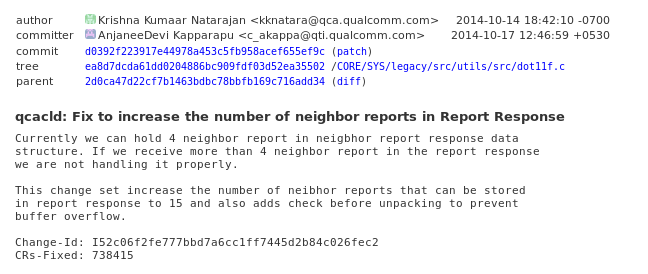
On October 14th 2014 QCA had the opportunity to kill this entire bug. Instead no one had the thought to say “Hey if this IE is vuln maybe there are more?”, so the bug lived on. This is a good time for me to point out that ALL developers need to think security while doing patches/writing code. Especially if it’s embedded systems/driver/C/C++ code. Had this developer had more training with security this bug could have been prevented.
The starts of an exploit using the above bug.
I want to thank Joshua J. Drake for helping with rewriting the PoCs so we didn’t have to rely on scapy and FakeAP. Also thanks for helping me with working towards an exploit.
Google Android Rewards program gives you the option to submit a working exploit that will get you up to $150k for remote kernel compromise:

I was very close to taking my 3 weeks of vacation from my job, and spending full time using this bug to get remote code execution. I emailed the Android Security guys to get clarification and it turns out my bug didn’t qualify. First because it’s proximal not remote, and second because I submitted all my bugs prior to June 1st I was only eligible for around $22k. Still a lot of money but that’s not worth me burning 3 weeks of vacation time.
My last thought on this: what they want is essentially a remote kernel compromise from SMS or webpage or something, not BT/WIFI stack. It’s my unsolicited opinion that $150k for remote kernel compromise through userland vector (requiring a long chain of exploits) on a Google Pixel phone is far too low. Even Zerodium pays too little, not that you should ever sell to those guys. It may be easy when you use some shit-old version of Android where Towel root still works, but when you’re using an up-to-date Google phone, getting kernel execution is no longer an easy task. This is why we’re seeing all these super bad bugs: Remote wifi via FW/Remote wifi via this driver. Google and Apple have successfully locked down kernel intrusion via a local route. Android’s SELinux policy is very strict, that coupled with forcing least privledge makes a local kernel compromise very difficult on Pixel phones.
Okay back to the technical details. I said above that this bug is good because there are a few regions of memory we can overflow. We can target BSS, Heap, and stack. Unfortunately for stack it’s not 2016 anymore where we could smash the stack and control the IP, thanks to Jeff’s commit:
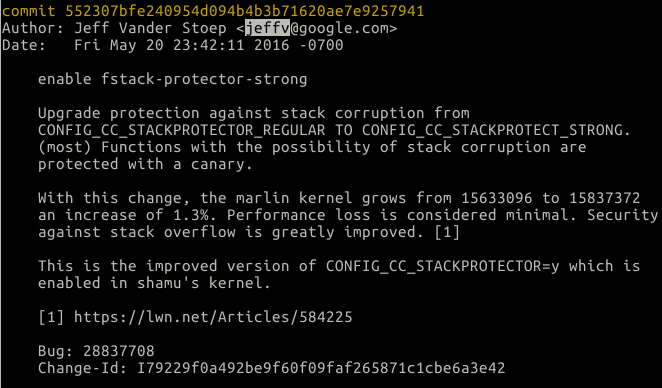
And unfortunately there are not any pointers or anything useful between our struct and the stack cookie. There are other locations in .bss which we can overflow, which can be a useful target. Under some BSS allocations there is this gigantic VosContext structure which we can overflow into. Another thing we can do is overflow a bss segment but not deep enough to hit VoScontext. This won’t cause any side effects because we don’t smash anything important. Later on there are a few locations where we copy our overflowed structures from .bss to heap:
tSirRetStatus
sirConvertAssocRespFrame2Struct(tpAniSirGlobal pMac,
tANI_U8 *pFrame,
tANI_U32 nFrame,
tpSirAssocRsp pAssocRsp)
{
/* pAssocRsp is allocated on the heap by the function that calls us */
static tDot11fAssocResponse ar;
tANI_U32 status;
tANI_U8 cnt =0;
// Zero-init our [out] parameter,
vos_mem_set( ( tANI_U8* )pAssocRsp, sizeof(tSirAssocRsp), 0 );
// delegate to the framesc-generated code,
status = dot11fUnpackAssocResponse( pMac, pFrame, nFrame, &ar);
...
...
...
#ifdef WLAN_FEATURE_VOWIFI_11R
if (ar.num_RICDataDesc) {
for (cnt=0; cnt < ar.num_RICDataDesc; cnt++) {
if (ar.RICDataDesc[cnt].present) {
vos_mem_copy( &pAssocRsp->RICData[cnt], &ar.RICDataDesc[cnt],
sizeof(tDot11fIERICDataDesc));
}
}
pAssocRsp->num_RICData = ar.num_RICDataDesc;
pAssocRsp->ricPresent = TRUE;
}
#endif
}From above, the parsing code overflowed ar.RICDataDesc[] and we control how many it overflowed, thus we control ar.num_RICDataDesc as well. So we can control how many RicDataDescs we shove into &pAssocRsp->RICData[cnt] where pAssocRsp is our heap allocation. So using this one simple trick we can pivot from a bss overflow to a heap overflow with mostly controlled data.
Unfortunately, at this point we both lost interest and stopped here.
Bug 2 (CVE-2017-9714) and 3 : Remote Kernel DoS (infinite loops)
These bugs probably won’t be exciting for the people looking to make exploits or love memory corruption. But these ones are super cute to me because they’re integer overflow bugs. When I was attending the University of Utah for my BS and MS I worked for a time and took classes from John Regehr his blog. This guy is one of the few experts of Undefined behavior in C and taught me literally everything I know about integers in C. One of my favorite blog posts, which is now defunct was “A Quiz About Integers in C”. Luckily I located it after doing some digging on Google. You can see the quiz here. The quiz highlights the type of stuff you need to know when auditing C code. A lot of times you’ll run into really strange scenarios which end up causing exploitable bugs later in the code.
When we put the phone into Access point mode for tethering there are some other management packets that are opened up for the driver to parse. Things like association requests, authentication requests, etc. If the phone is in AP mode and we send an association request we can send along something called “opaque RSN data” or “WPA Opaque data”. I don’t know what this crap is, but you can send it along which is all we care about.
If we do send it the 80211 parsing code in UnpackCore will place it nicely for us into the pAssocReq variable and will set pAssocReq->rsnPresent to one. We’ll continue on and eventually get to here in /lim/limProcessAssocReqFrame.c:
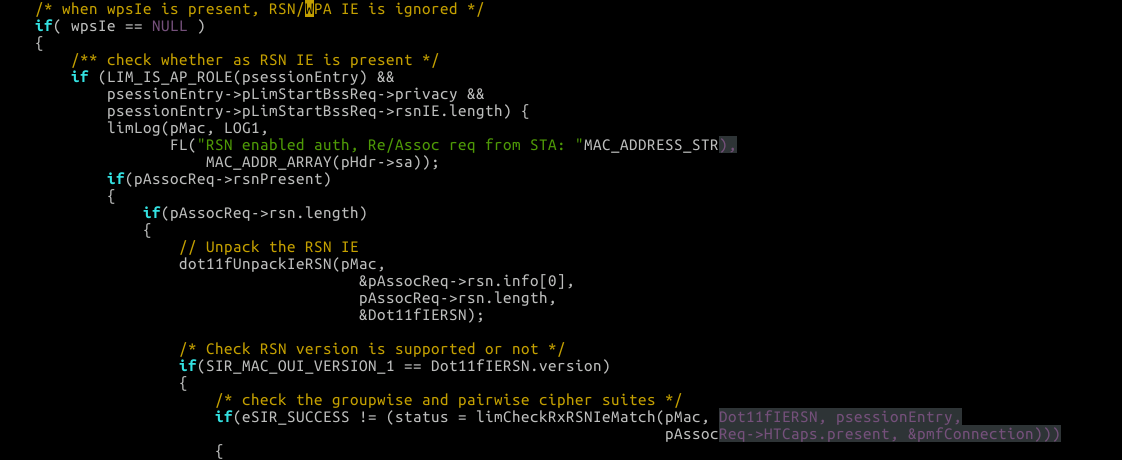
When we package along some RSN Data we will call dot11fUnpackIeRSN and pass the length/data to that function. Now the unpack function is tasked with converting the raw bytes to a c-style struct saving the results into the stack-based Dot11IERSN variable.
Let’s take a look at exactly what dot11fUnpackIeRSN does:
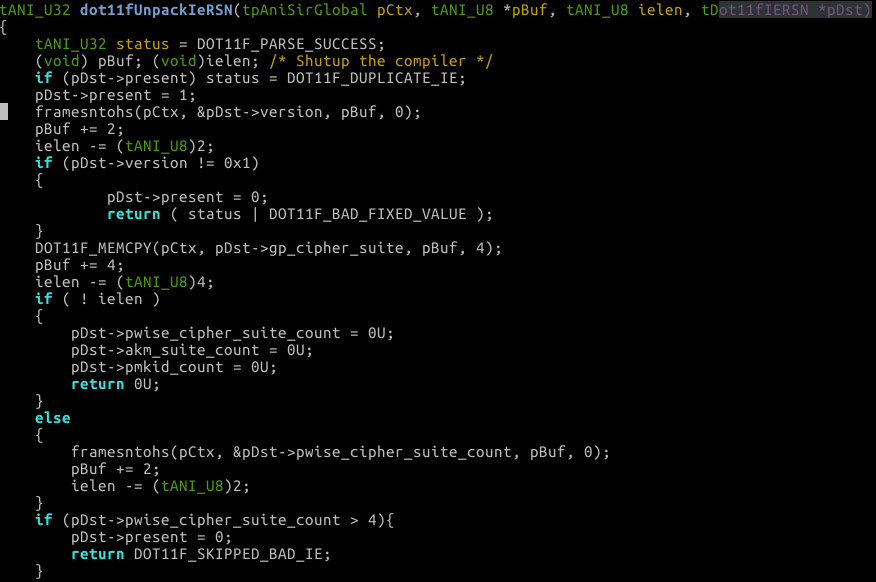
You can see we extract a pwise_cipher_suite_count from the raw buffer via the framesntohs call. Immediately after we verify that pwise_cipher_suite_count is less than four. If it’s larger we unset the present flag and return DOT11F_SKIPPED_BAD_IE; So this sorta sucks, they parse it correctly, and return an error if it’s bad. We can’t do anything… or can we?
If we take a step back look at how we call dot11fUnpackIeRSN you can see we call it the following way:
if(pAssocReq->rsn.length) {
// Unpack the RSN IE
dot11fUnpackIeRSN(pMac, &pAssocReq->rsn.info[0], pAssocReq->rsn.length, &Dot11fIERSN);See anything broken there? The calling function doesn’t ever check the return value of dot11fUnpackIeRSN. Continuing on with the code we will then call limCheckRxRSNIeMatch:
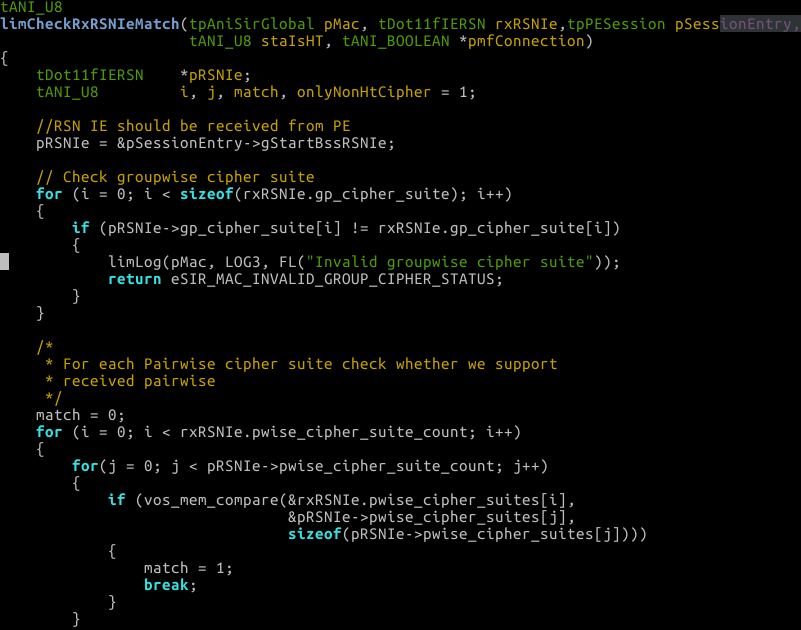
Take a look at the first loop and see if you can reason about why we can infinitely loop there. Here are some hints: What is the type of pwise_cipher_suite_count, (how did we extract pwise_cipher_suite_count)? What is the type of i?
Spoiler:
Since we fully control pwise_cipher_suite_count and it is a u16 (we extracted it with framesntohs (frames-network-to-host-short)) and the count variable (i) in the loop is of type u8 we can cause an infinite loop. If we send pwise_cipher_suite_count as 31337 dot11funpackiersn will fail, never unset pwise_cipher to 0, but it does return bad ie. We never check the return value and continue on into limCheckRxRSNIeMatch. We then enter into the for loop where pwise_cipher_suite_count is a u16 (31337) and u8 maxes out at 255 so the u8(i) keeps looping from 255 to 0 and will obviously never get to 31337 due to width constraints. So the for loop keeps spinning until the watchdogs kick in and nuke the kernel after awhile.
From above I said you can send WPA opaque data, which is true. It’s the same bug as above, a unchecked return value leading to a u8/u16 mismatch infinite loop.
Bug 3 Remote Dos part deux
This was one of the bugs on the chopping block for this blog post. The original fix was actually incorrect, so I re-reported the bug and the new fix is in the works.
Bug 4 Heap buffer overflow (CVE-2017-9714)
There is this “new” (circa 2014 it seems) portion of 802.11 management frames which can include some QoS type information. You can send it alone or you can append it onto 802.11 association reponse. Specifically, if we append a QoS Mapset element along with our association response we can cause some corruption, let’s see how.

As you can see in the above example, we set num_dscp_exceptions and then verify that the length is less than 60. Once we verify that we start walking out of the call chain and end up in sirConvertAssocRespFrame2Struct. At the end of this function we do the following:
if ( ar.QosMapSet.present )
{
pAssocRsp->QosMapSet.present = 1;
ConvertQosMapsetFrame( pMac, &pAssocRsp->QosMapSet, &ar.QosMapSet);
limLog( pMac, LOG1, FL("Received Assoc Response with Qos Map Set"));
limLogQosMapSet(pMac, &pAssocRsp->QosMapSet);
}We start converting from one struct to another struct by calling ConvertQosMapsetFrame( pMac, &pAssocRsp->QosMapSet, &ar.QosMapSet);
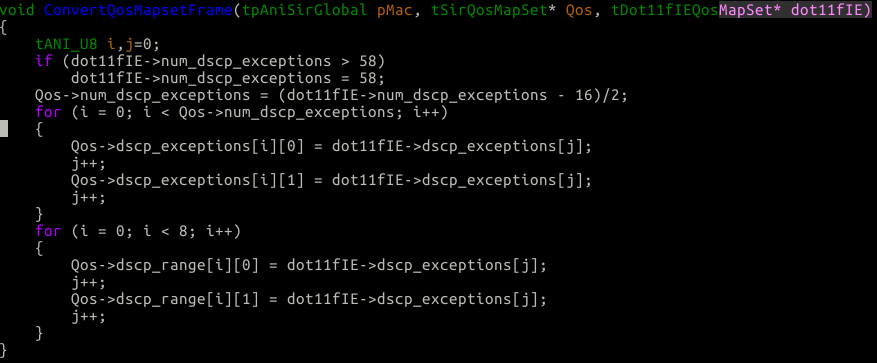
Looking at this function, it doesn’t really make any sense. If you go back up to the “Bug 4 Heap buffer overflow” header and look at the dot11fUnpackIeQosMapSet function again you can see we can put anywhere from 0 -> 60 bytes worth of data into the dscp_exceptions array. What ever amount of data we memcpy into that array we will set the size in pDst->num_dscp_exceptions.
Now let’s look again at the ConvertQosMapsetFrame function:
if (dot11fIE->num_dscp_exceptions > 58)
dot11fIE->num_dscp_exceptions = 58;
Qos->num_dscp_exceptions = (dot11fIE->num_dscp_exceptions - 16)/2;
for (i = 0; i < Qos->num_dscp_exceptions; i++)As you can see in the above example, if we have > 58 we set the max, but there is no minimum check. So, what if we send 14 num_dscp_exceptions? Well, we do 14 - 16, which promotes to integer math so we get (INT_MIN + 1) or 0xfffffffe. When we divide int(INT_MIN + 1) by 2 we get, INT_MIN. When we stuff a full 32 bit INT_MIN into a u8 we get 255 (we just take the bottom byte of the int).
So by sending 14 num_dscp_exceptions we can trick the code into storing 255 into Qos->num_dscp_exceptions then looping on it.
typedef struct sSirQosMapSet
{
tANI_U8 present;
tANI_U8 num_dscp_exceptions;
tANI_U8 dscp_exceptions[21][2];
tANI_U8 dscp_range[8][2];
} tSirQosMapSet, *tpSirQosMapSet;Above you can see there is 42 slots available for dscp_exceptions, so we blow off the end of this structure and into adjacent heap objects.
Bug 5 (CVE-2017-11014) Another Heap overflow.
The Qcacld driver has support for Roaming action frames which, I think are part of the 802.11k spec. This action frame is designed to assist 802.11 with Neighbor AP discovery, without having to do scans themself. It’s actually a cool idea because it was designed for power constraint devices, so they don’t have to continuously scan for networks to roam to. Instead they ask the current associated AP for list of known neighbors, and the AP will do the scan and return some info for the station.
The interesting thing is that the driver doesn’t even have to ask for this data. The access point can just send the roam action frame and qcacld will happily parse it.
So let’s send a Roam action frame and see what happens!
First we’ll get our way into the limProcessActionFrame() function.
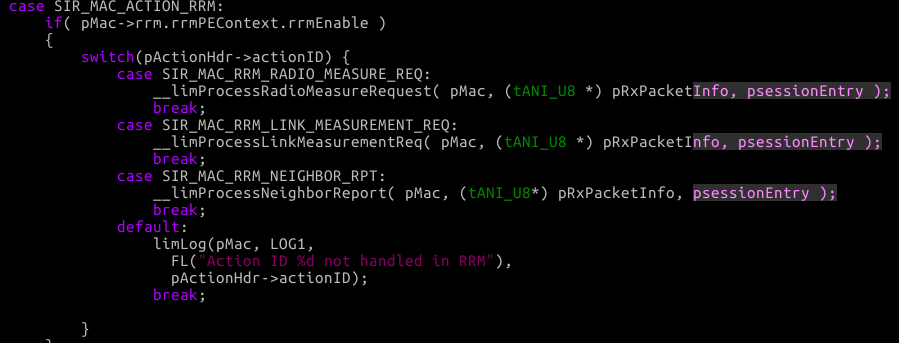
From there, since we’re sending a radio measure request we’ll enter __limProcessRadioMeasureRequest

Like every bug and ever packet we’ll hop into the dot11fUnpack function to parse it into our c-style structure. We’ll pass the following optional IEs array into UnpackCore. Remember from above, the IEs array describes the type of elements the parser expects to potentially be in the packet.
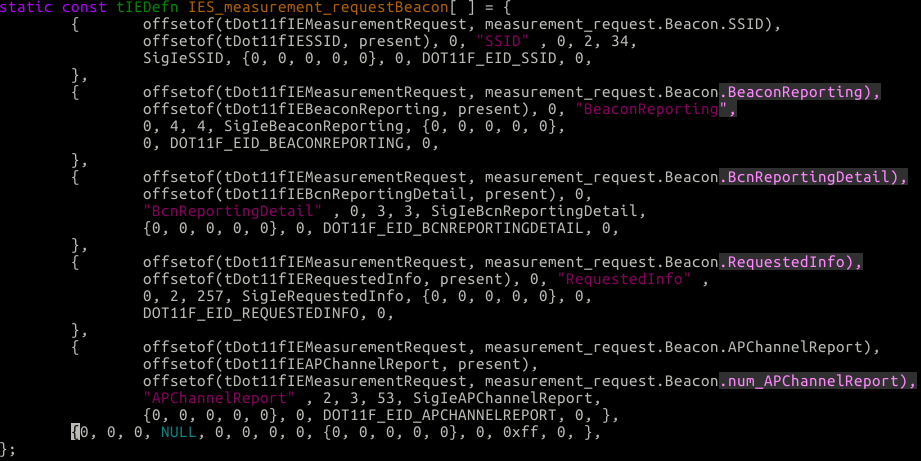
In this bug we’ll be focusing on the APChannel report functionality one can send with this packet.
offsetof(tDot11fIEMeasurementRequest, measurement_request.Beacon.APChannelReport),
offsetof(tDot11fIEAPChannelReport, present),
offsetof(tDot11fIEMeasurementRequest, measurement_request.Beacon.num_APChannelReport),
"APChannelReport" , 2, 3, 53, SigIeAPChannelReport)As you can see by the definition there is a num_APChannelReport, so we could use the first bug (CVE-2017-11013) on this structure. But let’s pretend it’s been fixed. Looking at this definition, we can send 2 AP channel reports (the number after the string is the arraybound). Now check out how we parse a AP channel report:
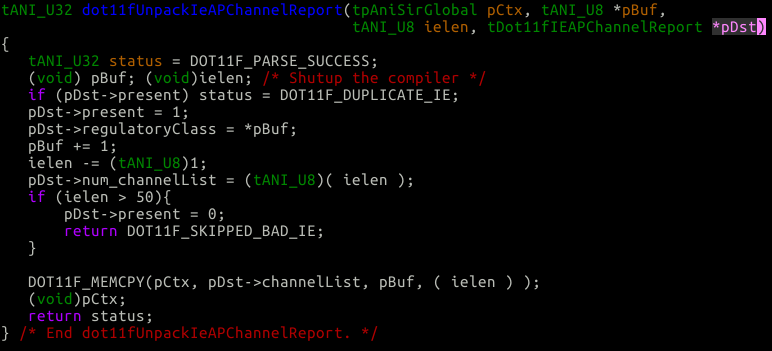
As you can see we bound the amount of channels by 50, which is okay as the pDst structure has 50 slots:
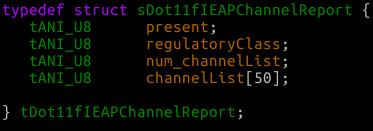
From above, we’re allowed to send 2 AP channel reports. In this scenario let’s send 2 reports of 50 each. Now we’ll unwind the call stack and land back into __limProcessRadioMeasureRequest where we’ll call rrmProcessRadioMeasurementRequest( pMac, pHdr->sa, &frm, psessionEntry ); &from contains our parsed frame, or pDst as it’s referred to in the parsing core.
Inside of rrmProcessRadioMeasurementRequest we see the following code (I skipped some irrelevant stuff):
![]()
You can see we call rrmProcessBeaconReportReq and one of the parameters we pass in is &pRRMReq->MeasurementRequest[i]. The structure we’re passing in contains our 2 AP reports. Now stepping into that function (and skipping some more code):

In the above code, we loop over our 2 AP channel reports and we store the channel list into pChanList. After each list we move the pointer forward, deeper into the destination array. Remember, we sent 50 channels per AP channel report. So after the first copy, we will move the pointer up 50 bytes. Let’s take a look at what tANI_U8 *pChanList = pSmeBcnReportReq->channelList.channelNumber; this channelNumber array looks like:

So pretty straight forward, let’s see how they typedef SIR_ESE_MAX_MEAS_IE_REQS:

So we’re storing 100 bytes (50 per ap report) into an array that was provisioned for 8 bytes… Nonsense.
Bug 6 (CVE-2017-11015) Another heap overflow
If we send a specially crafted authentication frame to the phone while it’s in AP mode we will eventually land in sirConvertAuthFrame2Struct which will immediately call dot11fUnpackAuthentication.
For an authentication packet we can attach some specific TLVs:
static const tIEDefn IES_Authentication[] = {
{offsetof(tDot11fAuthentication, ChallengeText), offsetof(tDot11fIEChallengeText, present), 0, "ChallengeText" , 0, 3, 255, SigIeChallengeText, {0, 0, 0, 0, 0}, 0, DOT11F_EID_CHALLENGETEXT, 0, },
{offsetof(tDot11fAuthentication, RSNOpaque), offsetof(tDot11fIERSNOpaque, present), 0, "RSNOpaque" , 0, 8, 255, SigIeRSNOpaque, {0, 0, 0, 0, 0}, 0, DOT11F_EID_RSNOPAQUE, 0, },
{offsetof(tDot11fAuthentication, MobilityDomain), offsetof(tDot11fIEMobilityDomain, present), 0, "MobilityDomain" , 0, 5, 5, SigIeMobilityDomain, {0, 0, 0, 0, 0}, 0, DOT11F_EID_MOBILITYDOMAIN, 0, },
{offsetof(tDot11fAuthentication, FTInfo), offsetof(tDot11fIEFTInfo, present), 0, "FTInfo" , 0, 84, 222, SigIeFTInfo, {0, 0, 0, 0, 0}, 0, DOT11F_EID_FTINFO, 0, },
{offsetof(tDot11fAuthentication, TimeoutInterval), offsetof(tDot11fIETimeoutInterval, present), 0, "TimeoutInterval" , 0, 7, 7, SigIeTimeoutInterval, {0, 0, 0, 0, 0}, 0, DOT11F_EID_TIMEOUTINTERVAL, 0, },
{offsetof(tDot11fAuthentication, RICDataDesc), offsetof(tDot11fIERICDataDesc, present), offsetof(tDot11fAuthentication, num_RICDataDesc), "RICDataDesc" , 2, 2, 550, SigIeRICDataDesc, {0, 0, 0, 0, 0}, 0, DOT11F_EID_RICDATADESC, 0, },
{0, 0, 0, NULL, 0, 0, 0, 0, {0, 0, 0, 0, 0}, 0, 0xff, 0, }, };The one of interest to us for our bug is the Challenge text. The challenge text is only useful in the WEP encryption scheme. Regardless if the phone’s AP has WEP enabled or not you can append this to the authentication frame and have the driver parse it. UnpackCore will call the specific parsing function for challenge text and we’ll arrive here:
tANI_U32 dot11fUnpackIeChallengeText(tpAniSirGlobal pCtx, tANI_U8 *pBuf, tANI_U8 ielen, tDot11fIEChallengeText *pDst)
{
tANI_U32 status = DOT11F_PARSE_SUCCESS;
(void) pBuf; (void)ielen; /* Shutup the compiler */
if (pDst->present) status = DOT11F_DUPLICATE_IE;
pDst->present = 1;
pDst->num_text = (tANI_U8)( ielen );
if (ielen > 253){
pDst->present = 0;
return DOT11F_SKIPPED_BAD_IE;
}
DOT11F_MEMCPY(pCtx, pDst->text, pBuf, ( ielen ) );
(void)pCtx;
return status;
} /* End dot11fUnpackIeChallengeText. */As you can see they bound the amount of challenge text to 253 bytes. When this function completes, UnpackCore, and dot11fUnpackAuthentication finish we’ll end up back in sirConvertAuthFrame2Struct where we will do the following:
// & "transliterate" from a 'tDot11fAuthentication' to a 'tSirMacAuthFrameBody'...
pAuth->authAlgoNumber = auth.AuthAlgo.algo;
pAuth->authTransactionSeqNumber = auth.AuthSeqNo.no;
pAuth->authStatusCode = auth.Status.status;
if ( auth.ChallengeText.present )
{
pAuth->type = SIR_MAC_CHALLENGE_TEXT_EID;
pAuth->length = auth.ChallengeText.num_text;
vos_mem_copy( pAuth->challengeText, auth.ChallengeText.text, auth.ChallengeText.num_text );
}This all looks pretty sane, but we need to see what this pAuth structure looks like. It comes in as a parameter to our auth convert function:
sirConvertAuthFrame2Struct(tpAniSirGlobal pMac,
tANI_U8 *pFrame,
tANI_U32 nFrame,
tpSirMacAuthFrameBody pAuth)
So it has type: tpSirMacAuthFrameBody which we find here:
typedef __ani_attr_pre_packed struct sSirMacAuthFrameBody
{
tANI_U16 authAlgoNumber;
tANI_U16 authTransactionSeqNumber;
tANI_U16 authStatusCode;
tANI_U8 type; // = SIR_MAC_CHALLENGE_TEXT_EID
tANI_U8 length; // = SIR_MAC_AUTH_CHALLENGE_LENGTH
tANI_U8 challengeText[SIR_MAC_AUTH_CHALLENGE_LENGTH];
} __ani_attr_packed tSirMacAuthFrameBody, *tpSirMacAuthFrameBody;Finally, we need to see how large SIR_MAC_AUTH_CHALLENGE_LENGTH really is.
#define SIR_MAC_AUTH_CHALLENGE_LENGTH 128
So challenge text has enough space for 128 bytes… but remember above, in the raw packet parsing we made the max length 253 bytes! So when we do the memcpy:
vos_mem_copy( pAuth->challengeText, auth.ChallengeText.text, auth.ChallengeText.num_text ); we copy 125 more bytes than the structure has allocated.
Bug 7 (CVE-???-????) Remote kernel stack disclosure
This bug is quite strange. It seems to be a case of a //TODO that never got TODO’d and thus lead to a pretty bad bug. Luckily this doesn’t affect the Nexus 5x nor the Pixel phones because while in AP mode, only WPA2 auth can be used. However this will probably affect other phones, and routers. When an AP is set up with WEP encryption (something you should never do) during the authentication phase of the 80211 protocol, the access point will send some “challenge text” to the authenticating station. It’s up to the station to use the encryption key to encrypt the challenge text and send it back to the access point. The access point will encrypt the challenge text as well and compare the response from the station. Assuming they match, the station is allowed on the network, and if not then the station must start over.
Now that we got that out of the way, let’s look at some code. When the driver recieves an authentication frame we’ll eventually enter ```limProcessAuthFrame`` in limProcessAuthFrame.c.
The prototype and local functions look like the following:
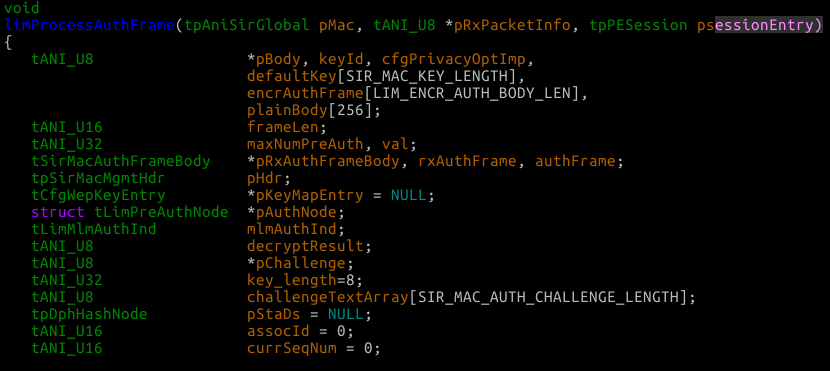
The thing I really want to point out with that image, is the challenge text array. It is a 128 byte char array, which we will in a bug-free world fill with some data for the station to encrypt.
Assuming we are in AP mode with a WEP key enabled we’ll continue into this function, and eventually get here:

Here we’re supposed to get some random bytes. Instead we don’t do that. Since C doesn’t pre-initalize anything on the stack, what ever valuable stack contents are there during this funciton call will be leaked in an 802.11 frame.
Bug 8 (CVE-???-????) Remote heap overflow
Coming to you sometime in the future – don’t know when.